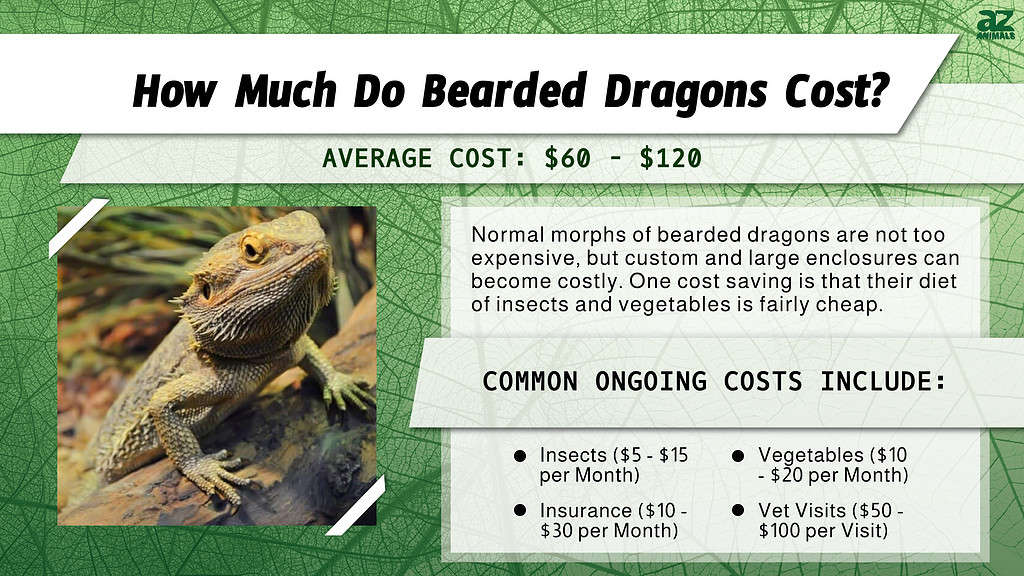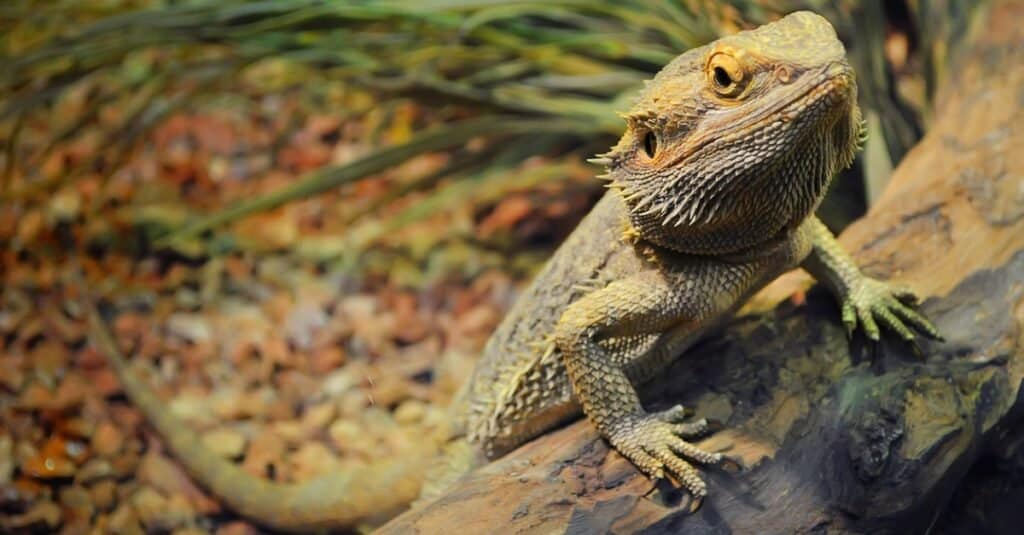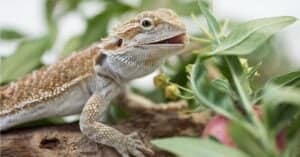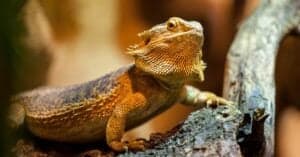Bearded dragons make excellent pets for anyone who has a love of reptiles. However, it is worth noting that these fun lizards can be a bit on the pricier side. Buying the bearded dragon itself won’t be the biggest cost. In reality, the cost for your initial setup and ongoing nutritional needs will be quite pricey.
Still, bearded dragons are worthwhile pets that are worth the cost. Let’s take a look at what you can expect in terms of bearded dragon prices. To start, though, let’s take a quick look at what bearded dragons are.
What are Bearded Dragons?
Due to their compelling nature and distinctive appearance, bearded dragons have become a popular choice for reptile lovers in the pet trade. These lizards are native to Australia’s dry areas and have adapted to thrive in a wide variety of settings, demonstrating their astounding adaptability.
Bearded Dragon Anatomy
Bearded dragons are distinguished by their robust body, triangular-shaped head, and, as the name implies, a beard-like structure in terms of look. Under their chin, they have a beard made of unique scales that they may grow out or darken to express their mood or show authority. They are shielded from the hostile environment by the thick, scaly coating covering their bodies. They come in a variety of hues, including brown, tan, yellow, and occasionally even streaks of red or orange. These animals can better blend with their environment because of their built-in camouflage.
Bearded Dragon Habitat
In the wild, bearded dragons can be found in a variety of dry and semi-arid habitats, such as deserts, wooded areas, and rocky regions. They thrive in hot, arid conditions and spend a lot of time basking in the sun to maintain a comfortable body temperature. In order to negotiate difficult terrain and establish perches in shrubs or trees, bearded dragons use their razor-sharp claws. Just as well, they have the ability to build tunnels to hide from harsh weather conditions or predators.
Bearded Dragons as Pets
Bearded dragons have gained popularity as pets because of their fascinating behavior and generally calm temperament. They are currently widely kept in captivity by many people, and they have established themselves in the reptile pet trade. Bearded dragons may flourish and form close relationships with their human caretakers when given the right care.
Replicating the natural environment is necessary to make a bearded dragon’s home acceptable for a pet. It is necessary to have a sizable terrarium or vivarium with suitable lighting, temperature gradients, and a range of surfaces for burrowing and climbing. To encourage their natural activity, the cage should also provide places for hiding, such as branches and pebbles. Bearded dragons are omnivores and consume a variety of foods, including leafy greens, fruits, and live insects like crickets and mealworms.
The tranquil nature of bearded dragons is one of the reasons they make excellent pets. They are typically calm and, with consistent care, may grow fairly tame. To guarantee their well-being, it is crucial to provide these animals with the right socialization and respect for their limits. Bearded dragons are renowned for their inquisitive temperament. They often observe their environment with keen eyes and display a variety of body language cues.
Having a bearded dragon as a pet needs dedication and care. They have particular care needs, such as sustaining ideal temperatures, offering a balanced diet, and scheduling routine veterinarian exams. In order to maintain their general health and adequate calcium metabolism, it is also essential to make sure they receive the right UVB illumination.

How Much Does a Bearded Dragon Cost?
The price of a bearded dragon can vary based on a number of variables, including its location, age, and health. But most significantly, its morph or genetic variety can have a major influence over its price. A bearded dragon can cost anywhere between $60 and $120 on average in 2023. It’s vital to keep in mind that this is only the first purchase cost and that there are other costs associated with giving these reptiles the required care and shelter.
A bearded dragon’s price can be significantly influenced by location. Due to increased availability and competition among breeders and pet retailers, bearded dragon prices may be cheaper in regions where they are more widely accessible. Due to restricted supply or greater shipping expenses, prices may be higher in regions where bearded dragons are less prevalent or have a higher demand.
Morphs and Higher Costs
The morph or genetic variety of a bearded dragon is another one of the main variables that affect its price. There are many different morphs of bearded dragons, and each one has a distinctive pattern and coloring. Morphs can be deliberately bred to improve particular characteristics or create uncommon color combinations, and this rarity and attractiveness can have a big influence on their price. Common morphs like the “normal” or “wild type” can be purchased for less money. However, rarer or more desirable morphs like hypo, leatherback, wero, or dunner morphs can fetch a greater price. Depending on their demand and rarity, prices for these morphs can range from a hundred dollars to several hundred dollars or more.
It’s important to remember that a bearded dragon’s initial adoption expense is just the beginning. The cost of giving your pet a sufficient habitat, food, lights, and veterinary care is continual. It’s important to take into account both the initial purchase price and ongoing costs for care when estimating the cost of a bearded dragon.

Bearded dragons (pictured) are not particularly expensive, especially if you’re purchasing a normal morph.
©Shinedawn/Shutterstock.com
How Much Do Bearded Dragon Supplies and Enclosures Cost?
The price of building a bearded dragon enclosure might vary based on the size of the enclosure, the caliber of the materials used, and the particular requirements of the dragon.
Enclosure
A terrarium or vivarium is often a good habitat for a bearded dragon. The dragon’s age and size will determine the size of the enclosure. The price range for a 40-gallon tank, which is ideal for a juvenile or small adult, is between $100 and $200. Larger enclosures, such as 75-gallon tanks or custom-made enclosures, can cost anywhere from $200 to $700 or more.
Substrate
Bearded dragons need a substrate that is safe and hygienic. Depending on the size and quality, options like ceramic tiles or reptile carpet are popular choices and can range in price from $20 to $50. If you want to provide your bearded dragon with the ability to dig, there are also special bearded dragon substrates available that also fall into that price range. Keep in mind that the substrate will need to be changed out regularly, which makes this a recurring expense.
Lighting
A bearded dragon’s health depends on having enough light. This necessitates the use of a heat lamp to provide a warm zone to bask in and a UVB light to emit the necessary UVB rays needed for beardies to grow. Depending on the brand and quality, UVB lamps can cost anywhere from $20 to $50 or more, while heat lamps can cost anywhere from $10 to $40.
Supplies
A bearded dragon enclosure also needs amenities like a basking platform, hiding places, climbing branches, and water and feeding bowls. Depending on the quantity and quality, the price of these supplies can vary, but a ballpark figure would be between $50 and $100 for everything.

Bearded dragons (pictured) enjoy enrichment items like a basking spot or naturalistic decor, which can be a bit pricey initially.
How Much Does It Cost to Feed a Bearded Dragon?
The price of feeding a bearded dragon as a pet can change based on a number of variables, including the bearded dragon’s size, age, and nutritional requirements. As omnivore reptiles, bearded dragons need a diversified diet that contains both plant material and animal protein.
Insects
Live insects make up the majority of a bearded dragon’s diet. Insects like crickets, mealworms, dubia roaches, and silkworms are what are usually fed to bearded dragons. Depending on where you buy them and how many you need, the price of these insects will change. Depending on the size and number, a container of crickets or mealworms might cost anywhere from $5 to $15. To cut expenses, some owners decide to breed their own insects. However, this takes time, effort, and a decent understanding of insect rearing.
Vegetables
Bearded dragons need a range of fresh vegetables, leafy greens, and fruits in addition to live insects. The price of these grocery items will vary depending on where you live and the season. To achieve a balanced diet, it is essential to include a variety of vegetables and greens in your beardie’s diet. These could include vegetables and fruits such as kale, collard greens, dandelion greens, bell peppers, squash, and carrots. Depending on the amount and availability, a bearded dragon’s fresh food expenses each month might range from $10 to $20.
It’s crucial to remember that bearded dragons’ nutritional requirements fluctuate as they become bigger. Adult dragons progressively shift to a diet that contains more plant materials, whereas juvenile dragons require a larger proportion of live insects. Given that live insects are sometimes more expensive than fresh vegetables, this change may have an impact on the cost of feeding.
Just as well, it’s critical to give your bearded dragon the right supplements to make sure it gets vital minerals like calcium and vitamin D3. The price range for these supplements, which normally come in powder form and last for several months, is between $10 and $15.
Depending on the size, age, and particular nutritional requirements of the bearded dragon, the average monthly food expense might be anywhere from $20 and $50. To preserve your bearded dragon’s health and well-being, it’s crucial to give it a balanced diet.
How Much Does Insurance for Bearded Dragons Cost?
Bearded dragon insurance may not be as popular as coverage for dogs or cats, but certain specialty pet insurance providers do provide protection for reptiles. The price of insurance for a bearded dragon will vary depending on the dragon’s age, health, and value as well as the coverage options selected.
Depending on the amount of protection and the insurance company, reptile insurance can cost anywhere from $10 and $30 each month. It’s crucial to keep in mind that not all insurance providers provide coverage specifically for bearded dragons, and availability and pricing may change based on where you live.
Understanding Coverage
Understanding the average coverage is crucial when thinking about reptile insurance. Typical coverage choices may include emergency treatment, prescription drugs, diagnostic testing, and veterinary expenditures for an illness or accident. Some plans may also provide liability coverage in the event that the dragon injures someone or destroys property, cover theft or loss of the dragon, or both. Reviewing the policy’s specifics, terms, and conditions is essential to understanding the coverage requirements, exclusions, and any associated deductibles or co-pays.
The choice to insure a bearded dragon is influenced by a number of elements, including the dragon’s worth and the possible cost of veterinary care. Although bearded dragons are typically seen of being robust and low-maintenance pets, they may nevertheless need veterinarian treatment for different illnesses or mishaps. Knowing that you are protected financially in the event of unanticipated medical costs might give you peace of mind when you insure your bearded dragon.
Researching and comparing insurance companies that provide coverage for reptiles is advised, taking into account aspects like reputation, client feedback, and the precise coverage provided. Before granting coverage, some firms would demand a veterinarian examination or health check-up, while others might impose waiting periods or exclude coverage for pre-existing diseases.

Bearded dragons (pictured) require regular vet visits as much as any other pet does.
©iStock.com/Kukurund
How Much Does a Bearded Dragon Vet Cost?
The price of taking a bearded dragon to the veterinarian might differ based on a number of variables, such as the region, the particular veterinary facility, the purpose of the visit, and the treatments or operations necessary. It’s vital to remember that veterinarian prices can vary greatly between locations and among practices.
A bearded dragon’s regular wellness checkup normally costs between $50 and $100. The vet will do a complete checkup, evaluate the dragon’s general health, and offer guidance on appropriate maintenance and management throughout these visits. Depending on the veterinarian’s qualifications and experience, the clinic’s amenities, and its equipment, the price may change.
Additional costs could be incurred if the bearded dragon needs diagnostic procedures like x-rays, blood tests, or fecal examinations. Depending on the complexity and quantity of tests run, the cost of these tests may range from $50 to $200 or more. It’s crucial to go through with the vet if these diagnostic tests are necessary and what they could cost.
Illness or Injury
The cost of veterinarian care may rise in the event of illness or injury. Depending on the severity and complexity of the problem, the price of treatments, drugs, or surgical procedures might vary greatly. Additional costs for hospitalization, emergency services, or specialist care may be incurred. Depending on the particular conditions and the necessary actions, prices for such scenarios might range from a few hundred to several thousand dollars.
When determining whether to adopt a bearded dragon into your life, it’s crucial to take into account the prospective financial costs of veterinary care. Taking care of a pet’s medical needs is one of the obligations that come with pet ownership. Having an emergency fund or thinking about pet insurance might lessen the financial strain brought on by unforeseen veterinary costs.
These fun little lizards can really make amazing pets if you can fit the ongoing costs to keep them in your budget. When it comes down to it, the initial costs are what will be the heftiest.
The photo featured at the top of this post is © Lutsenko_Oleksandr/Shutterstock.com
Thank you for reading! Have some feedback for us? Contact the AZ Animals editorial team.







